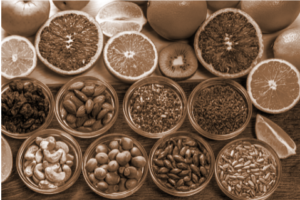Table of Contents

Definition:
The formation of seeds and fruits is the result of fertilization of the uterus and eggs in flowering plants. The ovary, after maturation, bears fruit, and the ovules inside the ovary, after fertilization, form sperm. Seed development and fruit formation are necessary for the plants to spread to remote areas. In addition, we use a variety of fruits and seeds. Therefore, the process of producing seeds and fruits has commercial value as well. Consumers, for example, prefer parthenocarpic or seedless seeds, and improperly planted hybrid seeds help growers to grow crops year-round at a low cost.
In angiosperms, two structures are formed as a result of double fertilization – the diploid zygote and the triploid main endosperm cell. The zygote develops into an embryo, while the endosperm cell produces an endosperm. It provides nutrients to the developing embryo. Both fruits and seeds are an important part of angiosperms.
Let’s take a closer look at the importance of fruits and seeds.
The Importance of Seed Formation
The following is the importance of seed formation:
- Reliable Approach: Seed formation is a reliable method. This is because pollen and the fertilization of seed plants do not need water.
- Perrenation: The seeds are dry and have a dormant embryo with a thick seed coat. Thus, it is appropriate for presentation during adverse conditions.
- Dispersion: Seeds have the ability to spread to new areas and grow there.
- Reserve Food: Seeds contain nutrients that are needed to feed young plants so that they can produce their own food.
- Changes: Seeds are produced by sexual reproduction. As a result, they carry with them a wide variety of adaptations that help them adapt to different environmental conditions.
storage Importance of Fruit Construction
The following is the importance of fruit formation:
- Protection: Growing fruits protect the seeds from adverse conditions, mechanical damage, and pests.
- Dispersion: Fruits aid in dispersing seeds in remote areas.
- Animal Food: Flesh fruits are eaten by animals that also propagate seeds elsewhere. Provide Nutritious Foods for Growing Seeds
Some fruits also provide nutrients for seed development and germination.
It is important to people
Fruits are an important source of food, organic acids, vitamins, minerals, proteins, fats, and sugars.
The seeds retain their food supply throughout the year, especially at bad times.
Seed and fruit formation by fertilization
Seed Construction
During the formation of seeds and fruits, sexual reproduction took place, and the zygote was formed. Various pollinating agents such as butterflies, wind, insects, and birds help build the zygote.
The zygote develops two layers and grows into an embryo, and a protective layer of seeds is formed from clusters.
Different parts of the flower lose their ability to fertilize, outside the ovary. As a result, seed and fruit formation occur simultaneously in plants.
The egg matures, and the embryo develops within the sperm. The basic structure of the seed is that of the eggs, which have new developed structures.
Fruit formation
On the other hand, when fertilized, the flower ovary will grow in stature, and the walls of the ovary will move away from the pericarp or fruit wall. The ovary may turn into a mature fruit or pulpy fruit and flesh, depending on the plant. Eventually, the sepals, stigma, stamen, petals, and flower styles fall apart.
Types of fruits
There are three types of fruit based on the number of flowers that participate in this process and the (free or combined) nature of the carpel in the gynoecium during fruit formation.
Simple fruits are formed from the mature ovary of a single flower. Therefore, gynoecium produces only one fruit. For example, an apple, papaya, a tomato, a plum, and watermelon are simple fruits.
These fruits are made from producing many ripe eggs from a single flower. These ovaries are called fruitless. Examples of mixed fruits are strawberries, blackberries, and raspberries.
The full inflorescence forms a composite fruit. That is why they are called many fruits. Examples are jackfruit, berries, and pineapple.
Seeds and fruit formation go hand in hand. The unique structure of seeds and fruits has evolved from a variety of plants.
These methods include,
- Apomixis: It is an asexual breeding method to produce seeds in plants, without the process of fertilization and meiosis. E.g-meadow grass, berries, etc.
- Parthenocarpy: Parthenocarpy is the process of producing seedless fruit as there is no fertilization of the ovules involved. E.g- Bananas, grapes, etc.
Importance of seeds and fruit formation in plants
Seed development and fruit formation are essential for the survival and propagation of plants. The fruit is developed to provide nutrients for unripe seeds. It protects the seeds from any external damage and helps the seeds to disperse to new habitats. On the other hand, the seed, being a propagating organ, helps to disperse species through a wide range of species. The seeds also provide nutrients and nutrients to the immature plant until it grows into a mature plant.
Also read: Important Topic Of Biology: Endosperm and Embryo
FAQs
What is the process of seed and fruit formation?
When the agents fertilize the ovary of a flower, the adult ovules become seeds. All parts of the flower except the ovary shrivel and fall off. The ovary becomes a fruit that encloses and protects the sperm.
Why is the formation of seeds and fruits important?
Fruits protect the seeds from external damage. It also helps the seeds to disperse in different areas. Seeds nourish a young plant until it grows into a mature plant.
What are the factors that depend on the growth of the seed and the composition of the fruit division?
Seed development and fruit differentiation depend on the number of cotyledons, the presence or absence of endosperm, the number of fertilized flowers, the free or integrated state of the carpel in the gynoecium.







